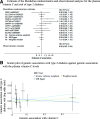Plasma Vitamin C and Type 2 Diabetes: Genome-Wide Association Study and Mendelian Randomization Analysis in European Populations
- PMID: 33203707
- PMCID: PMC7783939
- DOI: 10.2337/dc20-1328
Plasma Vitamin C and Type 2 Diabetes: Genome-Wide Association Study and Mendelian Randomization Analysis in European Populations
Abstract
Objective: Higher plasma vitamin C levels are associated with lower type 2 diabetes risk, but whether this association is causal is uncertain. To investigate this, we studied the association of genetically predicted plasma vitamin C with type 2 diabetes.
Research design and methods: We conducted genome-wide association studies of plasma vitamin C among 52,018 individuals of European ancestry to discover novel genetic variants. We performed Mendelian randomization analyses to estimate the association of genetically predicted differences in plasma vitamin C with type 2 diabetes in up to 80,983 case participants and 842,909 noncase participants. We compared this estimate with the observational association between plasma vitamin C and incident type 2 diabetes, including 8,133 case participants and 11,073 noncase participants.
Results: We identified 11 genomic regions associated with plasma vitamin C (P < 5 × 10-8), with the strongest signal at SLC23A1, and 10 novel genetic loci including SLC23A3, CHPT1, BCAS3, SNRPF, RER1, MAF, GSTA5, RGS14, AKT1, and FADS1. Plasma vitamin C was inversely associated with type 2 diabetes (hazard ratio per SD 0.88; 95% CI 0.82, 0.94), but there was no association between genetically predicted plasma vitamin C (excluding FADS1 variant due to its apparent pleiotropic effect) and type 2 diabetes (1.03; 95% CI 0.96, 1.10).
Conclusions: These findings indicate discordance between biochemically measured and genetically predicted plasma vitamin C levels in the association with type 2 diabetes among European populations. The null Mendelian randomization findings provide no strong evidence to suggest the use of vitamin C supplementation for type 2 diabetes prevention.
© 2020 by the American Diabetes Association.
Figures



References
-
- Harding AH, Wareham NJ, Bingham SA, et al. . Plasma vitamin C level, fruit and vegetable consumption, and the risk of new-onset type 2 diabetes mellitus: the European prospective investigation of cancer--Norfolk prospective study. Arch Intern Med 2008;168:1493–1499 - PubMed
-
- Ashor AW, Werner AD, Lara J, Willis ND, Mathers JC, Siervo M. Effects of vitamin C supplementation on glycaemic control: a systematic review and meta-analysis of randomised controlled trials. Eur J Clin Nutr 2017;71:1371–1380 - PubMed
-
- Didelez V, Sheehan N. Mendelian randomization as an instrumental variable approach to causal inference. Stat Methods Med Res 2007;16:309–330 - PubMed
Publication types
MeSH terms
Substances
Associated data
Grants and funding
- RG/13/13/30194/BHF_/British Heart Foundation/United Kingdom
- MC_UU_12015/1/MRC_/Medical Research Council/United Kingdom
- MC_UU_00006/3/MRC_/Medical Research Council/United Kingdom
- RG/08/014/BHF_/British Heart Foundation/United Kingdom
- RG71466/MRC_/Medical Research Council/United Kingdom
- MC_UU_12015/5/MRC_/Medical Research Council/United Kingdom
- MC_UU_00006/1/MRC_/Medical Research Council/United Kingdom
- MC_UU_00006/2/MRC_/Medical Research Council/United Kingdom
- 001/WHO_/World Health Organization/International
- SP/09/002/BHF_/British Heart Foundation/United Kingdom
- MR/L003120/1/MRC_/Medical Research Council/United Kingdom
- SJAH/004/MRC_/Medical Research Council/United Kingdom
- G0800270/MRC_/Medical Research Council/United Kingdom

